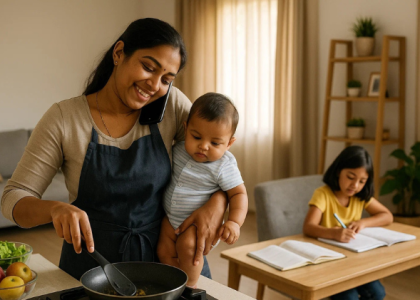In the shadow of our busy lives, many of us South Asian women have noticed our bodies changing. The sarees that once fit perfectly now feel a bit tighter. The walk up the stairs seems more challenging than before. If you’ve experienced this, please know you are not alone.
A Growing Concern in Our Community
Recent studies show a significant increase in obesity among South Asian women, especially in urban areas and states like Kerala. Kerala has one of the highest rates of abdominal obesity among women in India, with more than 65% of women affected. This is part of a larger pattern across affluent communities in India.
As someone who grew up in a traditional South Asian home, I understand the complex relationship we have with food and our bodies. Food is central to our culture – it’s how we show love, celebrate festivals, and maintain traditions. Yet, these same cultural practices may sometimes contribute to health challenges.
Our Traditional Eating Patterns
Many of us follow eating patterns established for generations:
- Four to five meals a day, including breakfast, lunch, evening snacks, and dinner
- Rice or roti as the foundation of most meals
- Multiple curries and side dishes at each sitting
- Sweet chai or coffee with snacks
- Traditional sweets and fried foods for celebrations
These patterns worked well for our grandmothers who spent hours doing physical household work. Research shows that traditional dietary patterns in India are being replaced by energy-dense foods with higher fat content, while physical activity has decreased significantly.
How Modern Life Has Changed Our Bodies
Our lifestyles have transformed dramatically in just one generation:
Reduced Physical Activity
Our mothers may have spent hours grinding spices, washing clothes by hand, and walking to the market. Today, appliances, vehicles, and delivery services have eliminated much of this natural exercise.
Career Demands and Stress
Many of us balance professional careers with family responsibilities. This constant juggling creates stress, which can affect our eating habits and contribute to weight gain.
Changing Food Environment
The urban food environment in India has changed significantly, with increased availability of processed foods, restaurant meals, and convenience options. Even our home cooking has evolved, with more oil and refined ingredients.
Social Expectations
In many affluent South Asian communities, abundant food is still seen as a sign of prosperity and care. Refusing food can sometimes be perceived as rejecting love.
Understanding Our Unique Challenges
South Asian women face specific challenges when it comes to weight management:
Body Composition
Studies show that South Asians may have higher body fat percentages at lower weights compared to other ethnic groups. This means we may experience health risks at what would be considered “normal” weights in Western standards.
Post-Pregnancy Weight
After childbirth, many South Asian women are encouraged to eat calorie-rich foods to recover. While these traditions have value, they sometimes make it difficult to return to pre-pregnancy weight.
Life Stage Transitions
As we enter our 40s and 50s, hormonal changes can affect how our bodies process food and store fat, making weight management more challenging.
Small Steps Toward Better Health
Making changes doesn’t mean rejecting our cultural identity or traditions. Instead, we can find gentle ways to adapt:
Mindful Rice Portions
Instead of filling half your plate with rice, try using a smaller katori (bowl) to serve yourself. This simple change can reduce calories while still enjoying your favorite foods.
Walking After Meals
A 10-minute walk after eating is a wonderful traditional practice that helps digestion and blood sugar control. Invite family members to join you for this short stroll.
Add Before You Subtract
Rather than focusing on what to remove from your diet, try adding more vegetables to your plate first. This naturally leaves less room for higher-calorie options.
Redefine Hospitality
When hosting guests, consider offering fresh fruit alongside traditional sweets, giving everyone choices that honor both tradition and health.
Find Movement You Enjoy
Whether it’s traditional dance, yoga, or walking with friends, finding physical activity that brings you joy makes it easier to stay consistent.
Vimala’s Story
Vimala, a 45-year-old teacher from Kochi, noticed her weight increasing after her children grew up and left home. “I was still cooking and eating the same amounts, but I was no longer running after active children all day,” she explains.
Instead of drastic changes, Vimala started with small adjustments. She began serving herself rice in a small bowl instead of a large plate. She invited neighborhood aunties for morning walks. She experimented with reducing oil in curries just a little at a time.
“After six months, my clothes fit better, and I had more energy,” she says. “My family still enjoys the same foods, just prepared with small, thoughtful changes.”
A Compassionate Approach
Our bodies have carried us through life’s joys and challenges. They deserve care, respect, and kindness. Making changes to support our health isn’t about pursuing a certain appearance or rejecting our cultural heritage. It’s about honoring our bodies so we can remain strong and vibrant for our families and communities.
Health experts recommend focusing on small, sustainable changes rather than strict diets or intense exercise programs that are difficult to maintain. Research from across South and Southeast Asia shows that modest lifestyle adjustments maintained over time are more effective than dramatic short-term changes.
Beginning Your Journey
If you’re concerned about your weight and how it might affect your health, consider these gentle first steps:
- Speak with a healthcare provider who understands South Asian health patterns
- Start a walking routine, even just 10 minutes after dinner
- Use smaller plates and bowls for meals
- Add one extra vegetable to your daily meals
- Involve family members in preparing healthier versions of favorite recipes
Remember that good health is a journey, not a destination. Each small step matters, and progress isn’t always linear. Be patient with yourself as you find your own balance between honoring traditions and caring for your wellbeing.
Your health matters—not just for yourself, but for all those who love and depend on you. By taking small steps today, you’re creating the foundation for many more years of strength, joy, and vitality to share with those you love.
This article was written specifically for South Asian women by health educators at SouthAsianHeart.com who understand our unique cultural context and health needs.




